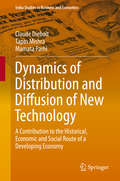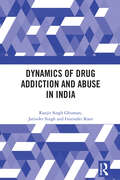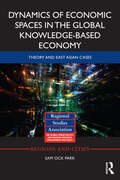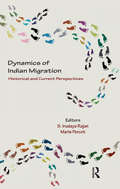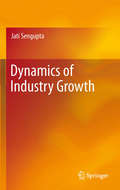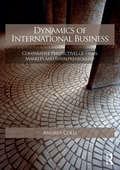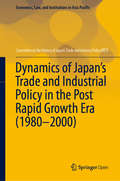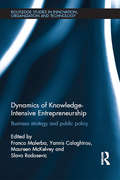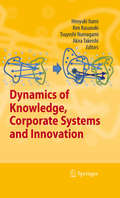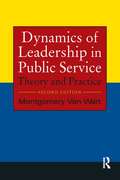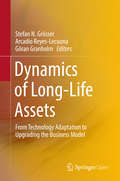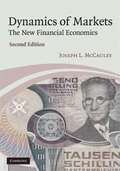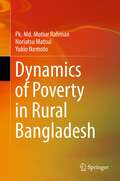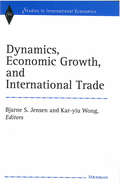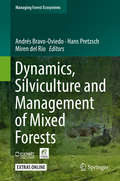- Table View
- List View
Dynamics of Distribution and Diffusion of New Technology
by Claude Diebolt Tapas Mishra Mamata ParhiThis book presents a comprehensive study of adoption and diffusion of technology in developing countries in a historical perspective. Combining the development of growth trajectories of the Indian economy in general and its manufacturing industry in particular, the book highlights the effective marriage between qualitative and quantitative methods for a better understanding and explaining of many hidden dynamic behaviors of adoption and diffusion trend in manufacturing industry. The use of various econometric methods is aimed to equip readers to make a judgement of the current state of diffusion pattern of new technologies in India and simulate a desirable future pattern in view of the various pro-industrial growth policies.
Dynamics of Drug Addiction and Abuse in India
by Jatinder Singh Ranjit Singh Ghuman Gurinder KaurThis book analyzes drug addiction and abuse from the perspectives of the state and community in India, with a special focus on North-West regions of India. India lies in the transit route of two major global centres of heroin and cocaine processing: the Golden Triangle of Myanmar, Thailand and Laos towards the East; and the Golden Crescent of Afghanistan, Iran and Pakistan to the West making it vulnerable to drug trafficking and curbing this has been a tough challenge for enforcement agencies. The book looks at: the nature and pattern of drug addiction across the age groups, gender and occupational groups, both in rural and urban areas in India; the socio-economic causes of drug-use and addiction and the various socio-economic costs associated with it; the general perception of family members, police and political leaders on drug addiction as well as rehabilitation; and available mechanisms to address the issue at the level of family, society and government and the changes required in policy to curb drug addiction and use This interdisciplinary book will be of importance to students and researchers of economics, cultural and social anthropology, sociology, police administration, political science, and psychology. It will also be of interest to policy makers, government agencies, social scientists, departments of social and preventive medicine, social workers, civil society, drug-addicts and their families.
Dynamics of Economic Spaces in the Global Knowledge-based Economy: Theory and East Asian Cases (Regions and Cities)
by Sam Ock ParkThis book addresses how economic spaces dynamically change within the context of the global knowledge-based economy. Specifically, it centers the discussion on integrated views of understanding and conceptualizing dynamic changes of global economy under the global megatrends of globalization, knowledge-based economy, information society, service world, climate change, and population aging. Focusing on East Asia, especially on Korea, it deals with case studies regarding the processes and patterns of these global dynamics, looking at economic spaces of various spatial scales and types of economic actors. This book develops a theoretical model for understanding and analysing the dynamics of economic spaces that are being reshaped within the larger global economy. It also emphasizes the analysis of empirical studies at the level of firm, region, and state by considering an evolutionary perspective over time. In developing its theoretical framework, this book examines regional resilience, intangible assets, service innovation, path dependence, and other notions related to the evolution of economic spaces, and incorporates these elements into real-world case studies. The integrated theoretical framework examined here contributes a new perspective on spatial disparities in the global economy. An integral model of service innovation; the integration of path dependence and regional resilience; the interaction between firm and region for the accumulation of intangible assets; and the roles of governments and global firms: these are all essential to understanding the dynamics of economic spaces in East Asia. The theoretical model and case studies in this book suggest policy implications for developing countries, especially in the Asian and African regions, with regard to regional development and innovation policies.
Dynamics of Energy, Environment and Economy: A Sustainability Perspective (Lecture Notes in Energy #77)
by Muhammad Asif Hassan Qudrat-UllahThe book addresses the vital and interwoven areas of energy, environment, and the economy within the field of sustainability research. Fundamental technical details, empirical data, and case studies taking into account local and international perspectives are included. Issues such as energy security, depleting fossil fuel reserves, global warming and climate change, as well as novel energy technologies are covered. The dynamic global response will be discussed from the perspective of policy, technology, and economics.Vital details in the form of text boxes, illustrations, graphs, tables and appendices are included. The book will serve as reference book for upper-level undergraduate and graduate students, researchers, academics, policy makers, NGOs and developmental sector professionals within the field.
Dynamics of Indian Migration: Historical and Current Perspectives
by S. Irudaya RajanThis volume is a multidisciplinary approach to the subject of Indian international emigration and comprises contributions by demographers, economists, sociologists, geographers, anthropologists and historians. The book highlights emerging issues such as the political economy of international migration, skilled and unskilled migration, body shopping, return migration, immigration policies in the Gulf and experiences of emigrants from the states of Kerala and Punjab. It focuses on the current dimensions like skilled migrants in the IT sector of Malaysia, the entrepreneurial ventures of Keralites in the UAE, household remittances, inequality and poverty in Kerala, the gender dimension of Indian migration (with focus on nurses and housemaids in the Gulf) and cross-border migratory movements connected to the European Union, with an overview of the migration of Sikhs and Tamils to France. Finally, it carries a discussion of the evolution of India’s public policies towards its diaspora.
Dynamics of Industrial Capitalism: Schumpeter, Chandler, and the New Economy (The\graz Schumpeter Lectures)
by Richard N. LangloisCo-winner of the 2006 Schumpeter Prize of the International Joseph A. Schumpeter Society.This book explains the shift of the organizational landscape away from vertically integrated firms and towards more specialized entities connected by markets and networks. In doing so, it places in a larger theoretical framework the work of Joseph Schumpeter an
Dynamics of Industry Growth
by Jati SenguptaEconomic growth of a country depends on its industries. The focus of modern growth theory is basically macroeconomics, although neoclassical models use competitive markets and the optimization behavior of households and firms in general equilibrium framework. The emphasis here is on industry growth, where the microfoundations of industry are analyzed in terms of economic efficiency. The various linkages which link firm growth with the industry growth are discerned here under various market structures both competitive and monopolistic. The role of information in facilitating market signals and allowing the adoption of new processes has been especially emphasized in this volume. Many issues of market failure and the suboptimality of competitive equilibria are due to incomplete and imperfect information structures and we need a comprehensive theory of information structures underlying the process of industry growth and its dynamics. This book will be of interest to economists studying economic and industry growth and innovation.
Dynamics of Information Systems: Algorithmic Approaches
by Panos M. Pardalos Alexey SorokinDynamics of Information Systems: Algorithmic Approaches presents recent developments and results found by participants of the Fourth International Conference on the Dynamics of Information Systems, which took place at the University of Florida, Gainesville FL, USA on February 20-22, 2012. The purpose of this conference was to bring together scientists and engineers from industry, government, and universities to exchange knowledge and results in a broad range of topics relevant to the theory and practice of the dynamics of information systems. Dynamics of Information plays an increasingly critical role in our society. The influence of information on social, biological, genetic, and military systems must be better understood to achieve large advances in the capability and understanding of these systems. Applications are widespread and include: detection of terrorist networks, design of highly efficient businesses, computer networks, quantum entanglement, genome modeling, multi-robotic systems, and industrial and manufacturing safety. The book contains state-of-the-art work on theory and practice relevant to the dynamics of information systems. It covers algorithmic approaches to numerical computations with infinite and infinitesimal numbers; presents important problems arising in service-oriented systems, such as dynamic composition and analysis of modern service-oriented information systems and estimation of customer service times on a rail network from GPS data; addresses the complexity of the problems arising in stochastic and distributed systems; and discusses modulating communication for improving multi-agent learning convergence. Network issues--in particular minimum-risk maximum-clique problems, vulnerability of sensor networks, influence diffusion, community detection, and link prediction in social network analysis, as well as a comparative analysis of algorithms for transmission network expansion planning--are described in later chapters.
Dynamics of Information Systems: Mathematical Foundations
by Panos M. Pardalos My T. Thai Robert Murphey Alexey SorokinThis book presents recent developments and results found by participants of the Third International Conference on the Dynamics of Information Systems, which took place at the University of Florida, Gainesville FL, USA on February 16-18, 2011. The purpose of this conference was to bring together scientists and engineers from industry, government, and universities to exchange knowledge and results in a broad range of topics relevant to the theory and practice of the dynamics of information systems. Dynamics of Information plays an increasingly critical role in our society. The influence of information on social, biological, genetic, and military systems must be better understood to achieve large advances in the capability and understanding of these systems. Applications are widespread and include: research in evolutionary theory, optimization of information workflow, military applications, climate networks, collision work, and much more. Dynamics of Information plays an increasingly critical role in our society. The influence of information on social, biological, genetic, and military systems must be better understood to achieve large advances in the capability and understanding of these systems. Applications are widespread and include: research in evolutionary theory, optimization of information workflow, military applications, climate networks, collision work, and much more.
Dynamics of Innovation in Industry
by James M. UtterbackIn this chapter, the author examines important moments of innovation in the history of the typewriter, extracting some common patterns in order to begin constructing a general model for implementing innovative strategies to ensure long-term success.
Dynamics of Institutional Change in Emerging Market Economies: Theories, Concepts and Mechanisms (Contributions to Economics)
by Nezameddin Faghih Ali Hussein SamadiEconomic, social, political, and cultural institutions, and institutional change reflect shared journeys of humanity throughout history. This edited volume explores dynamics, trends, and implications of institutional change in emerging markets, by focusing on theories, concepts, and mechanisms of institutional development. Presenting research by eminent scholars and experts engaged in education and research, they address and discuss the most recent issues in the field, reveals new insights into the dynamics of institutional change for researchers interested in development of new theories and comparative studies, especially in the era of emerging markets.Topics range from dynamics of institutional change and development within the Group of Twenty (G20), and the European Union with an assessment of Brexit impact, to institutional quality measurement, public administration reforms, as well as emergent topics such as the effects of energy and globalization. It provides new international business theories, and sheds light on the way to global peace by producing a better understanding of the dynamics of historical change. The book is intended for a wide range of global audience, and should serve as a useful reference in education and research, offering innovative and productive discussions, as well as satisfy scholarly and intellectual interests, regarding institutional development and a broad spectrum of its interactions with functioning of markets and economies.
Dynamics of International Business
by Prem Ramburuth Christina Stringer Manuel Serapio Prem Ramburuth Christina StringerDynamics of International Business: Asia-Pacific Business Cases brings the challenges and complexities of the contemporary international business environment into the classroom. These authentic case studies, based on recent research and events, enable students to engage with the economic, social, political and intercultural factors that impact on international business and understand how these factors are addressed in the real world. Designed to facilitate a problem-based learning approach, the cases in this book: • draw on a diverse range of businesses and industries – from seafood to video games to renewable energy • illustrate fundamental themes and concerns within global business, including ethics, sustainability, emerging markets and cultural and legal differences • span many countries across the Asia-Pacific region • include discussion questions that encourage students to apply international business theory in the context of realistic scenarios • include references and suggestions for further reading. Extra resources for instructors, including case synopses and learning objectives, are available on the companion website at www. cambridge. edu. au/academic/internationalbusiness.
Dynamics of International Business: Comparative Perspectives of Firms, Markets and Entrepreneurship
by Andrea ColliThe Dynamics of International Business offers a comparative, chronological overview of the strategic and structural evolution of international firms. Organized around eras of global economic development, the text synthesizes research on the internationalization of firms, highlighting crucial turning points in the evolution of the international economy. A particular emphasis is placed on the relationship between historical evidence and the theoretical frameworks available for its interpretation. Each period is illustrated by a selection of short case studies from a variety of industry sectors, including the Levant Company, Nestlé, Singer, Saint Gobain and NEC. An essential textbook for courses in business and economic history, this book will also be a valuable resource for scholars and students of international business more generally.
Dynamics of Japan’s Trade and Industrial Policy in the Post Rapid Growth Era (Economics, Law, and Institutions in Asia Pacific)
by RIETIThis open access book provides an in-depth examination of Japan's policy responses to the economic challenges of the 1980s and '90s. While MITI's earlier role in promoting rapid growth has been addressed in other studies, this volume, based on official records and exhaustive interviews, is the first to examine the aftermath of rapid growth and the evolution of MITI's interpretation of the economy's changing needs. Covering such topics as the oil shocks, trade conflict with the United States, and the rise and collapse of the so-called bubble economy, it presents a detailed analysis and evaluation of how these challenges were interpreted by government officials, the kinds of policies that were enacted, the extent to which policy aims were realized, and lessons for the longer term. This book is recommended especially to officials of countries concerned about the challenges that follow on high economic growth and to readers interested in Japan’s contemporary economic history.
Dynamics of Knowledge Intensive Entrepreneurship: Business Strategy and Public Policy (Routledge Studies in Innovation, Organizations and Technology)
by Franco Malerba Yannis Caloghirou Maureen McKelvey Slavo RadosevicKnowledge intensive entrepreneurship lies at the core of the structural shift necessary for the growth and development of a knowledge based economy, yet research reveals that the EU has fewer young leading innovators, and Europe’s new firms do not adequately contribute to industrial growth. This is especially true in the high R&D intensive, high-tech sectors. This structural malaise, undermining Europe’s growth potential, is well diagnosed, but poorly understood. This volume fills this important gap by exploring new firms that have significant knowledge intensity in their activity and develop and exploit innovative opportunities in diverse sectors. Through an evolutionary and systemic approach to entrepreneurship, focusing on knowledge intensive entrepreneurship as both a micro and a macro phenomena and analyzing firms in the context of various socio-economic models, the authors explore firms creation and origins around the world, their organization, strategies and business models as well as the role of innovation systems and institutions in their formation and growth. This comprehensive research text is vital reading for academics, researchers and students of high-tech and knowledge intensive entrepreneurship as well as those with an interest in industrial dynamics, innovation management and public policy.
Dynamics of Knowledge, Corporate Systems and Innovation
by Ken Kusunoki Hiroyuki Itami Tsuyoshi Numagami Akira TakeishiThe theme of the book exactly matches the title: the dynamics of knowledge, the corporate system and innovation. Knowledge is created and accumulated in the corporate system, which seeks to utilize it to introduce innovation to the market and society. Corporate organizations generate new knowledge through their in-house R&D activities, and introduce new products and services to the market by combining their own new knowledge and the knowledge generated by others, e.g. universities. Thus, the corporate system is the essential linchpin between knowledge and innovation, and the interactive dynamics between knowledge, the corporate system, and innovation are extremely important. To understand and guide innovative activities in the society, deeper insights into these dynamics are crucial. This book is a step forward in that direction.
Dynamics of Leadership in Public Service: Theory and Practice
by Montgomery Van WartEminently readible, current, and comprhensive, this acclaimed text sets the standard for instruction in
Dynamics of Long-Life Assets
by Stefan N. Grösser Arcadio Reyes-Lecuona Göran GranholmThis book is published under a CC BY-NC 4. 0 license. The editors present essential methods and tools to support a holistic approach to the challenge of system upgrades and innovation in the context of high-value products and services. The approach presented here is based on three main pillars: an adaptation mechanism based on a broad understanding of system dependencies; efficient use of system knowledge through involvement of actors throughout the process; and technological solutions to enable efficient actor communication and information handling. The book provides readers with a better understanding of the factors that influence decisions, and put forward solutions to facilitate the rapid adaptation to changes in the business environment and customer needs through intelligent upgrade interventions. Further, it examines a number of sample cases from various contexts including car manufacturing, utilities, shipping and the furniture industry. The book offers a valuable resource for both academics and practitioners interested in the upgrading of capital-intensive products and services. "The work performed in the project "Use-It-Wisely (UiW)" significantly contributes towards a collaborative way of working. Moreover, it offers comprehensive system modelling to identify business opportunities and develop technical solutions within industrial value networks. The developed UiW-framework fills a void and offers a great opportunity. The naval construction sector of small passenger vessels, for instance, is one industry that can benefit. " Nikitas Nikitakos, Professor at University of the Aegean, Department of Shipping, Trade, and Transport, Greece. "Long-life assets are crucial for both the future competiveness and sustainability of society. Make wrong choices now and you are locked into a wrong system for a long time. Make the right choices now and society can prosper. This book gives important information about how manufacturers can make right choices. " Arnold Tukker, Scientific director, Institute of Environmental Sciences (CML), Leiden University, and senior scientist, TNO.
Dynamics of Markets: The New Financial Economics (2nd edition)
by Joseph L. MccauleyThis second edition presents the advances made in finance market analysis since 2005. The book provides a careful introduction to stochastic methods along with approximate ensembles for a single, historic time series. The new edition explains the history leading up to the biggest economic disaster of the 21st century. Empirical evidence for finance market instability under deregulation is given, together with a history of the explosion of the US Dollar worldwide. A model shows how bounds set by a central bank stabilized FX in the gold standard era, illustrating the effect of regulations. The book presents economic and finance theory thoroughly and critically, including rational expectations, cointegration and arch/garch methods, and replaces several of those misconceptions by empirically based ideas. This book will be of interest to finance theorists, traders, economists, physicists and engineers, and leads the reader to the frontier of research in time series analysis.
Dynamics of Organizational Ambidexterity: Studies from a Processual Constructivist Perspective (Markt- und Unternehmensentwicklung Markets and Organisations)
by Elena Krause-SöhnerElena Krause-Söhner explores how the dynamics of organizational ambidexterity can be managed in complex organizations. This is a relevant question as today’s organizations and the individuals within them face the challenge of focusing on short term improvements while simultaneously targeting long-term innovation in a dynamic environment. Drawing on a practice-based perspective and the view of organizations as socially constructed and constantly changing entities, organizational enacting and constructing change activities are investigated based on profound conceptual and empirical base in an industry and service context. This book derives implications for both the theoretical discourse and for practitioners.
Dynamics of Poverty in Rural Bangladesh
by Noriatsu Matsui Yukio Ikemoto Pk. Md. RahmanThe study of poverty dynamics is important for effective poverty alleviation policies because the changes in income poverty are also accompanied by changes in socioeconomic factors such as literacy, gender parity in school, health care, infant mortality, and asset holdings. In order to examine the dynamics of poverty, information from 1,212 households in 32 rural villages in Bangladesh was collected in December 2004 and December 2009. This book reports the analytical results from quantitative and qualitative surveys from the same households at two points of time, which yielded the panel data for understanding the changes in situations of poverty. Efforts have been made to include the most recent research from diverse disciplines including economics, statistics, anthropology, education, health care, and vulnerability study. Specifically, findings from logistic regression analysis, polychoric principal component analysis, kernel density function, income mobility with the help of the Markov chain model, and child nutrition status from anthropometric measures have been presented. Asset holdings and liabilities of the chronically poor as well as those of three other economic groups (the descending non-poor, the ascending poor, and the non-poor) are analyzed statistically. The degrees of vulnerability to poverty are examined by years of schooling, landholding size, gender of household head, social capital, and occupation. The multiple logistic regression model was used to identify important risk factors for a household's vulnerability. In 2009, some of the basic characteristics of the chronically poor were: higher percentage and number of female-headed households, higher dependency ratio, lower levels of education, fewer years of schooling, and limited employment. There was a low degree of mobility of households from one poverty status to another in the period 2004-2009, implying that the process of economic development and high economic growth in the macroeconomy during this time failed to improve the poverty situation in rural Bangladesh.
Dynamics of Rational Negotiation: Game Theory, Language Games and Forms of Life
by Margit Gaffal Jesús Padilla GálvezThis book uses game theory to analyze the strategies developed in negotiation processes. Offering a detailed analysis of competition and cooperation, it explores various bargaining strategies that result from the application of Nash equilibrium and mixed strategies. Employing a blend of game theory and real-world examples, the authors describe typical negotiation scenarios and unveil the art of negotiation strategy – dissecting both competitive and cooperative tactics.This comprehensive analysis explores the multifaceted dimensions of negotiation, highlighting not only formal aspects but also the economic, social, political, and human factors at play. The authors discuss the basic structures of cooperative and non-cooperative games and conduct a comprehensive analysis of the language games that take place in negotiations. They examine how negotiators belonging to different forms of life can trade with each other when their respective language games are different and prone to misinterpretation. The book also probes arbitration and mediation as conflict-resolution tools within this intricate landscape. Designed for the curious minds seeking insight into negotiation strategies, as well as students and scholars of diverse fields, this book fosters an understanding of negotiation's labyrinthine pathways. "Dynamics of Rational Negotiation" unlocks the door to negotiation's complexities, inviting readers to unravel the layers of human interaction.
Dynamics of the Mixed Economy: Toward a Theory of Interventionism (Routledge Foundations of the Market Economy)
by Sanford IkedaDynamics of the Mixed Economy applies the insights of modern Austrian political economy to examine economic policy in mixed economies. It compares and contrasts standard approaches to the growth of the state (including public choice) with that of modern Austrian political economy; examines in detail the nature and operation of the interventionist process in the context of nationalization, regulation and the welfare state; analyzes conditions that produce instability under laissez-faire capitalism; argues that the interventionist process is a 'spontaneous order'; and offers several 'pattern predictions' regarding the character and behaviour of really existing economies.
Dynamics, Economic Growth, and International Trade
by Bjarne S. Jensen Kar-Yiu WongWhile endogenous growth theory has claimed success in modeling various factors of growth and providing an analysis of sustainable economic growth, most of the growth models in published work are for closed economies. The omission of international trade, which is often regarded as the engine of growth, greatly reduces their usefulness. The theory of international trade, on the other hand, is characterized by models that are mainly static. While interest in the dynamics of trade has been growing, there is still little work in this area. The success of the newly industrialized economies that have adopted trade-oriented policies suggests how limited present trade theory is in explaining and analyzing the growth of these economies. The work collected here serves to bridge the "old" growth theory and "new" growth theory; merge growth and trade theory; suggest new analysis and techniques of economic growth; and provide analysis of new issues related to growth and trade. The first chapter surveys endogenous growth and international trade and critically reviews the endogenous growth theory with a unified framework, covering the work on both closed and open economies. Three chapters examine the dynamics of some basic trade models; two chapters focus on growth and trade with endogenous accumulation of human and public capital; two chapters on economic growth, technological progress, and international trade; and two chapters on growth and international factor movements.
Dynamics, Silviculture and Management of Mixed Forests (Managing Forest Ecosystems #31)
by Hans Pretzsch Andrés Bravo-Oviedo Miren Del RíoThe capacity of mixed forests to mitigate climate change effects by increasing resilience and lowering risks is pinpointed as an opportunity to highlight the role of tree species rich forests as part of complex socio-ecological systems. This book updates and presents the state-of-the-art of mixed forest performance in terms of regeneration, growth, yield and delivery of ecosystem services. Examples from more than 20 countries in Europe, North Africa and South America provide insights on the interplay between structure and functionining, stability, silviculture and optimization of management of this type of forests. The book also analyses the role of natural mixed forests and mixed plantations in the delivery of ecosystem services and the best modelling strategy to study mixed forest dynamics. The book is intended to serve as a reference tool for students, researchers and professionals concerned about the management of mixed forests in a context of social and environmental change.
